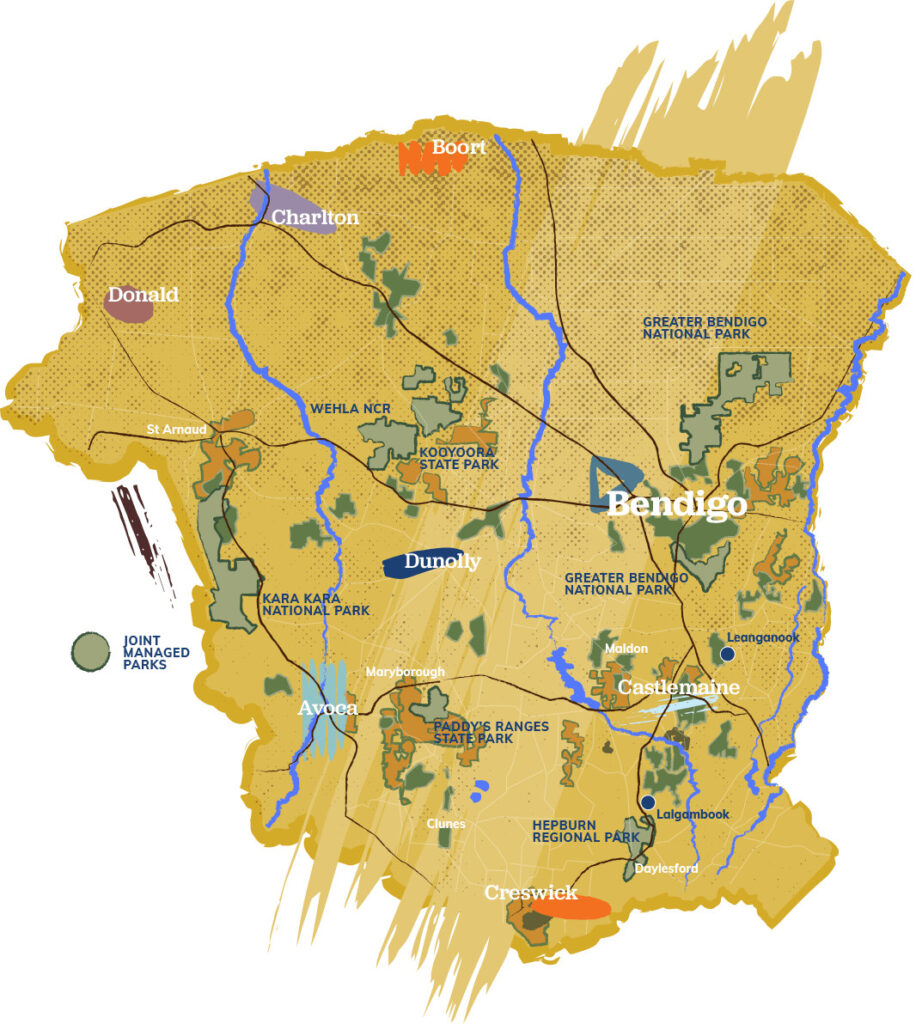
Bunjil, the Wedge-tailed Eagle
For at least 40,000 years, in Victoria’s central goldfields region, the Dja Dja Wurrung people sustained themselves and the land through their knowledge of local plants, animals, seasons, fire and geology – a knowledge passed down the centuries through stories, lore and language. The Dja Dja Wurrung are made up from 16 clans and are part of the Kulin alliance of Victorian Aboriginal peoples.
The Dja Dja Wurrung are bound to their land by their spiritual belief system deriving from the Dreaming, when mythic beings had created the world, the people and their culture. In their dreaming stories, the land and people were created by Bunjil, the Wedge-tailed Eagle, while the laws and ceremonies that ensured the continuation of life were enforced by Mindi, the Giant Serpent. The landscape was embedded with names, songs, ancestors, and murrups – spirits inhabiting the water, birds, plants, animals, rocks and mountains.
Their lands once extended over 16,000 square kilometres. They were part of established trade networks which allowed goods and information to flow over substantial distances. The Tachylite deposits, (a hard glassy stone that was valued and traded to use for stone weapons and tools), near Spring Hill and the Coliban River were important trade goods as stone artifacts from this material have been found around Victoria.

Dja Dja Wurrung Traditional Lands
At the time of first contact with Europeans, in the early 1800s, the Dja Dja Wurrung population was estimated to be about 2,000 people. Diseases introduced by the Europeans, along with murders and massacres reduced their population significantly so that by 1840 there was only 282 people remaining. The onset of the Victorian Gold Rush in 1851 placed further pressure on the Dja Dja Wurrung with 10,000 diggers occupying Barkers Creek, Mount Alexander and many streams turned into alluvial gold diggings with many sacred sites violated. The gold rush also caused a crisis in agricultural labour, so many of the squatters employed Dja Dja Wurrung people as shepherds, stockriders, station hands and domestic servants on a seasonal or semi-permanent basis.
The environmental devastation caused by gold mining was widespread and permanent in the district, decimating and displacing the Dja Dja Wurrung, whose water sources included the rivers, creeks and associated underground springs. Mining destroyed the infrastructure they created over generations to maximise seasonal drainage patterns; channels and weirs they built out of timber stakes, to slow receding summer flows, were wrecked; water holes where the people gathered in smaller groups during periods of scarce rainfall and from which they transported water in skin bags when moving, were muddied, polluted and drained; the soaks they had dug between banks into sandy sediment to tap into the water table were likewise obliterated.
On 28 March 2013, the State of Victoria and the Dja Dja Wurrung people entered into a Recognition and Settlement Agreement under the Victorian government’s Traditional Owner Settlement Act 2010, which formally recognises the Dja Dja Wurrung people as the traditional owners for part of Central Victoria. The Dja Dja Wurrung are the traditional owners of lands including the water catchment areas of the Loddon and Avoca rivers.
Information from https://en.wikipedia.org/wiki/Djadjawurrung
The Castlemaine Maryborough Rail Trail committee has been working with the Dja Dja Wurrung including their providing smoking ceremonies for events and information gathering tours for the Feasibility Study Control Group. Stage Two of the Rail Trail Project includes developing a Cultural Heritage Management Plan which will be lead by the Dja Dja Wurrung. The future Trail will feature information sites along the Trail to highlight the importance of the Dja Dja Wurrung to our Trail and the surrounding environment.
.
